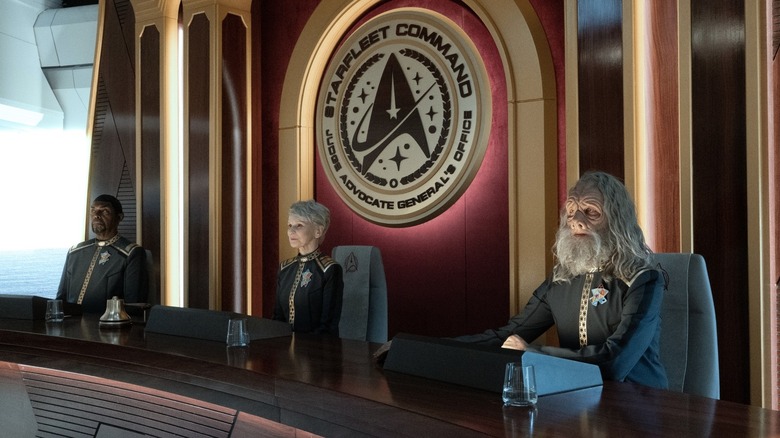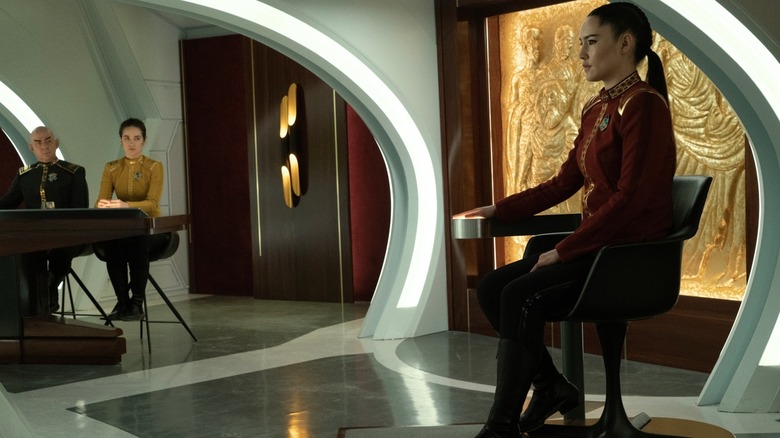How Strange New Worlds' Use Of The Volume Echoes Star Trek's Holodeck [Exclusive]
This post contains spoilers for the season 2 "Star Trek: Strange New Worlds" episode, "Ad Astra per Aspera."
The technology is improving.
Back in December of 2021, /Film posted an article about AR or Augmented Reality technology that was employed by the makers of "Star Trek: Discovery." AR is essentially an advanced version of rear-projection technology, wherein actors stand in front of a screen to supplement their environment. Unlike the old days, however, where an actual 35mm projector would project pre-recorded footage onto a screen behind an actor while they acted in a scene, AR backgrounds are elaborate LED screens that can adjust as filming commences in real-time. A background will be pre-rendered on a computer and then broadcast onto a wall-sized screen. The movements of the camera are then tied into the pre-rendered background, and the scenery will shift itself depending on where the camera moves.
The actors can move around in the prerequisite stage space and while the cameras follow them, the scenery shifts to and fro. It can be disorienting for an actor, but it looks more dynamic than a locked-down backdrop painting. It's also a lot faster than shooting an actor on a green screen and rendering a digital background after the fact.
/Film's own Danielle Ryan recently spoke to Valerie Weiss, the director of the "Star Trek: Strange New Worlds" episode "Ad Astra per Aspera," and it seems that the newer show is also using AR walls for its backgrounds, although the process is clearly a lot more streamlined in 2023; apart from the Enterprise's mess hall and an office building on the distant planet of Illyria, all of the sets were virtual. One can barely tell.
Ryan and Weiss talked about working with AR tech — virtual soundstages are called volumes — and how it very much resembles Trek's own holodeck technology.
The volume
Valerie Weiss wanted to point out that there were still some actual sets involved on "Star Trek: Strange New Worlds," and that shooting on location is hardly forbidden. But for the most part, sets are built in the volume (tables, chairs, desks, etc.), while the walls are virtual. Weiss, it seems, rather enjoys the new technology, and has fun shooting with it. She said:
"We actually also shot on location as well. So the Illyrian Colony, where Pike goes to visit Neera to solicit her help, is a location in Toronto. And then everything's a set except for the mess hall, that's on the volume. And it's so much fun to shoot that shoot on the volume. It's just you can do anything there, obviously. And it's also, you can work so much faster there because you're lighting basically from the walls, and so you don't have a lot of practical lights getting in the way of shots. So it's a very exciting process to work in the volume."
Ryan was quick to point out the similarities between a volume and a holodeck. Holodecks, as Trekkies all know, are rooms outfitted with holographic projectors that can simulate entire environments. Holodecks can also make furniture, props, and virtual people, so it's quite a way in the future from a volume, but the "simulated environment" part seems to have been nailed. Weiss added:
"[T]he courtroom, I think people know by now that I think it was the "Discovery" set. So Jonathan Lee, our brilliant production designer, converted that to be our courtroom. And I think ... there's a really great interview with him talking about how he did that and the choices he made for the gold relief background, and it's a lovely, lovely set."
Brilliant.
More on the volume
According to the website Daily Trek News, the virtual background screens are manufactured by a company called Pixmondo. Pixmondo worked on Martin Scorsese's "Hugo," "Star Trek Into Darkness," and the recent "Ant-Man and the Wasp: Quantumania." The AR wall is about 70 feet wide, 30 feet tall, and curves around the volume for about 270 degrees. The volume also has a moveable ceiling that can be equipped with an additional AR screen, or outfitted with practical lights. To Weiss' point, however, if the background wall is illuminated, then practical lights are going to be less necessary.
The cameras, as mentioned, are outfitted with motion-tracking technology, allowing the background image to move according to its location. Faraway objects on the AR wall, for instance, will shift a small amount, while closer images move more quickly. The photographers on "Discovery" appreciate their convenience and speed. Video game players might compare it to the visual phenomenon of parallax scrolling.
Other shows also use the volume, notably the hit Disney+ show "The Mandalorian." That show's cinematographer Grieg Fraser, once spoke extensively about AR walls with American Cinematographer Magazine, pointing to how well it works and how it is visually superior to both rear-screen projection and green-screen soundstages. There is no rendering after the fact when shooting in a volume. This, it seems, is the future of sci-fi TV.
No word yet as to whether or not we can create an artificially intelligent Moriarty, though.


